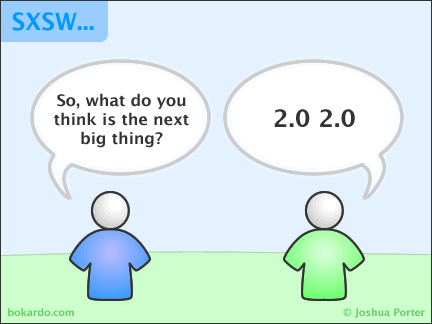March 12th
Comic: 2.0 2.0

Continue Reading: Comic: 2.0 2.0
TAG: Web 2.0
February 7th
How an over-focus on technology and visual design can hide the real value of social software.
In a fascinating piece on the amazing growth of the photo-sharing site Fotolog, Jason Kottke clearly articulates a growing problem in design:
“Fotolog…relative to Flickr…has changed little in the past couple of years. Fotolog has groups and message boards, but they’re not done as well as Flickr’s and there’s no tags, no APIs, no JavaScript widgets, no “embed this photo on your blog/MySpace”, and no helpful Ajax design elements, all supposedly required elements for a successful site in the Web 2.0 era. Even now, Fotolog’s feature set and design remains planted firmly in Web 1.0 territory.”
How do sites with sub-optimal visual design and technology grow so big and become so successful?
Continue Reading: How to Prevent Valueless Design in Social Web Sites
December 20th
Nicholas Carr has a great post on Sharecropping the long tail “One of the fundamental economic characteristics of Web 2.0 is the distribution of production into the hands of the many and the concentration of the economic rewards into the hands of the few. It’s a sharecropping system, but the sharecroppers are generally happy because […]
Continue Reading: The Value of Self-expression
December 11th
Tim O’Reilly is returning to the definition he started with: Web 2.0 is the Web as Platform. This is the definition that got me interested in Web 2.0 in the first place. It makes sense, easily contrasts with “desktop as platform”, and is accurate: we are seeing a tremendous platform move to the Web. Unfortunately, […]
Continue Reading: Web as Platform
September 19th
Grazr.com relaunched late yesterday with a host of new features. (Marshall Kirkpatrick has the Techcrunch writeup) I helped with the site redesign, focusing on demonstrating the capabilities of Grazr as well as making the activity of building a Grazr painless and easy.
One of the new features that I’m most excited about is the ability to watch video from any web page. Here’s a Grazr displaying YouTube videos:
So it’s as simple as that. You can browse YouTube from any web site with a Grazr!
Continue Reading: Grazr Goes 1.0, Relaunches with Video
August 11th
Didn’t anticipate the power of network effects…
Continue Reading: Why Netscape Will Succeed
August 4th
A short rant about lying to customers.
Continue Reading: My Number is Bigger than Yours
May 16th
A second helping of reasons why web apps fail.
Continue Reading: 7 More Reasons Why Web Apps Fail
May 5th
A few ideas about why some of the web apps out there fail.
Continue Reading: 7 Reasons Why Web Apps Fail
April 21st
Derek Powazek in The Wisdom of Browse:
“As the web matures, and we get better at developing member-driven media sites like Digg, we have to look beyond simplistic majority-rule popularity contests if we ever want to take on traditional editor-driven media. People are complicated, and we’re going to need complicated systems to really draw the wisdom out of the crowd.”
This follows hot on the heels of my recent post The One Crucial Idea of Web 2.0 as well as Ajit’s insight into collective intelligence, where he recast Web 2.0 principles underneath the umbrella of the Wisdom of Crowds. (collective intelligence) Alex has a nice writeup on this, too.
I’m confident that we’re seeing another insight from networked life here. The insight is that we can aggregate the wisdom of crowds, but only under certain circumstances and perhaps only for so long without evolving our systems. The recent Digg.com blowup is evidence that our systems need to adapt as their users adapt.
For those not familiar with the Wisdom of Crowds…